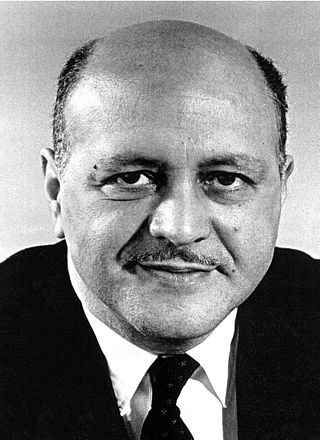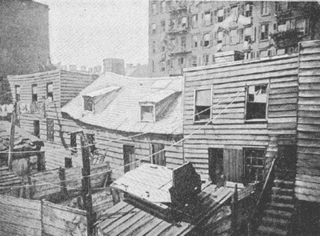Related Research Articles

The Great Society was a set of domestic programs in the United States launched by Democratic President Lyndon B. Johnson in 1964–65. The term was first referenced during a 1964 speech by President Lyndon B. Johnson at Ohio University, then later formally presented at the University of Michigan, and came to represent his domestic agenda. The main goal was the total elimination of poverty and racial injustice.

The United States Department of Housing and Urban Development (HUD) is one of the executive departments of the U.S. federal government. It administers federal housing and urban development laws. It is headed by the Secretary of Housing and Urban Development, who reports directly to the President of the United States and is a member of the president's Cabinet.
The Community Development Block Grant (CDBG), one of the longest-running programs of the U.S. Department of Housing and Urban Development, funds local community development activities with the stated goal of providing affordable housing, anti-poverty programs, and infrastructure development. CDBG, like other block grant programs, differ from categorical grants, made for specific purposes, in that they are subject to less federal oversight and are largely used at the discretion of the state and local governments and their subgrantees.

Urban renewal is a program of land redevelopment often used to address urban decay in cities. Urban renewal involves the clearing out of blighted areas in inner cities to clear out slums and create opportunities for higher class housing, businesses, and other developments.
The Fair Deal was a set of proposals put forward by U.S. President Harry S. Truman to Congress in 1945 and in his January 1949 State of the Union address. More generally, the term characterizes the entire domestic agenda of the Truman administration, from 1945 to 1953. It offered new proposals to continue New Deal liberalism, but with a conservative coalition controlling Congress, only a few of its major initiatives became law and then only if they had considerable GOP support. As Richard Neustadt concludes, the most important proposals were aid to education, national health insurance, the Fair Employment Practices Commission, and repeal of the Taft–Hartley Act. They were all debated at length, then voted down. Nevertheless, enough smaller and less controversial items passed that liberals could claim some success.
The term New Frontier was used by Democratic presidential candidate John F. Kennedy in his acceptance speech in the 1960 United States presidential election to the Democratic National Convention at the Los Angeles Memorial Coliseum as the Democratic slogan to inspire America to support him. The phrase developed into a label for his administration's domestic and foreign programs.
We stand today on the edge of a New Frontier—the frontier of the 1960s, the frontier of unknown opportunities and perils, the frontier of unfilled hopes and unfilled threats. ... The pioneers gave up their safety, their comfort, and sometimes their lives to build our new west. They were determined to make the new world strong and free - an example to the world. ... Some would say that those struggles are all over, that all the horizons have been explored, that all the battles have been won. That there is no longer an American frontier. ... And we stand today on the edge of a new frontier, the frontier of unknown opportunities and perils. ... Beyond that frontier are uncharted areas of science and space, unsolved problems of peace and war, unconquered problems of ignorance and prejudice, unanswered questions of poverty and surplus. ... I'm asking each of you to be pioneers towards that New Frontier. My call is to the young in heart, regardless of age. ... Can we carry through in an age where we will witness not only new breakthroughs in weapons of destruction, but also a race for mastery of the sky and the rain, the ocean and the tides, the far side of space, and the inside of men's minds? ... All mankind waits upon our decision. A whole world waits to see what we shall do. And we cannot fail that trust, and we cannot fail to try.

Robert Clifton Weaver was an American economist, academic, and political administrator who served as the first United States secretary of housing and urban development (HUD) from 1966 to 1968, when the department was newly established by President Lyndon B. Johnson. Weaver was the first African American to be appointed to a US cabinet-level position.

The Model Cities Program was an element of U.S. President Lyndon Johnson's Great Society and War on Poverty. The concept was presented by labor leader Walter Reuther to President Johnson in an off-the-record White House meeting on May 20, 1965. In 1966, new legislation led to the more than 150 five-year-long, Model Cities experiments to develop new antipoverty programs and alternative forms of municipal government. Model cities represented a new approach that emphasized social program as well as physical renewal, and sought to coordinate the actions of numerous government agencies in a multifaceted attack on the complex roots of urban poverty. The ambitious federal urban aid program succeeded in fostering a new generation of mostly black urban leaders. The program ended in 1974.
The Atlanta Housing Authority (AHA) is an agency that provides affordable housing for low-income families in Atlanta. Today, the AHA is the largest housing agency in Georgia and one of the largest in the United States, serving approximately 50,000 people.

The Housing Act of 1937, formally the "United States Housing Act of 1937" and sometimes called the Wagner–Steagall Act, provided for subsidies to be paid from the United States federal government to local public housing agencies (LHAs) to improve living conditions for low-income families.

In the United States, subsidized housing is administered by federal, state and local agencies to provide subsidized rental assistance for low-income households. Public housing is priced much below the market rate, allowing people to live in more convenient locations rather than move away from the city in search of lower rents. In most federally-funded rental assistance programs, the tenants' monthly rent is set at 30% of their household income. Now increasingly provided in a variety of settings and formats, originally public housing in the U.S. consisted primarily of one or more concentrated blocks of low-rise and/or high-rise apartment buildings. These complexes are operated by state and local housing authorities which are authorized and funded by the United States Department of Housing and Urban Development (HUD). In 2020, there were 1 million public housing units.
The HUD Reports were a series of studies in mass transit systems, funded by the Urban Mass Transportation Administration (UMTA) department of the United States Department of Housing and Urban Development (HUD). The HUD reports were extremely influential in the development of the personal rapid transit (PRT) concept, small pod-like vehicles that automatically travel from point-to-point in extended networks. Their publication in early 1968 sparked off PRT development projects at dozens of companies around the world. In spite of intense interest in the early 1970s, political winds shifted and today there is only one HUD-inspired PRT system in commercial operation, the Morgantown PRT in West Virginia.

The Housing and Urban Development Act of 1965 is a major revision to federal housing policy in the United States which instituted several major expansions in federal housing programs.

The Office of Fair Housing and Equal Opportunity (FHEO) is an agency within the United States Department of Housing and Urban Development. FHEO is responsible for administering and enforcing federal fair housing laws and establishing policies that make sure all Americans have equal access to the housing of their choice.

The Economic Opportunity Act of 1964 authorized the formation of local Community Action Agencies as part of the War on Poverty. These agencies are directly regulated by the federal government. "It is the purpose of The Economic Opportunity Act to strengthen, supplement, and coordinate efforts in furtherance of that policy".

The Housing and Urban Development Act of 1968, Pub. L. 90–448, 82 Stat. 476, enacted August 1, 1968, was passed during the Lyndon B. Johnson Administration. The act came on the heels of major riots across cities throughout the U.S. in 1967, the assassination of Civil Rights Leader Martin Luther King Jr. in April 1968, and the publication of the report of the Kerner Commission, which recommended major expansions in public funding and support of urban areas. President Lyndon B. Johnson referred to the legislation as one of the most significant laws ever passed in the U.S., due to its scale and ambition. The act's declared intention was constructing or rehabilitating 26 million housing units, 6 million of these for low- and moderate-income families, over the next 10 years.

The Federal-Aid Highway Act of 1968 is legislation enacted by the United States Congress and signed into law on August 24, 1968, which expanded the Interstate Highway System by 1,500 miles (2,400 km); provided funding for new interstate, primary, and secondary roads in the United States; explicitly applied the environmental protections of the Department of Transportation Act of 1966 to federal highway projects; and applied the Davis–Bacon Act to all highway construction funded by the federal government. It established three new programs: a National Bridge Inspection Program, funding and fair housing standards for those displaced by federally funded highway construction, and a traffic operations study program.

Fire Research and Safety Act of 1968 was a declaration for a panoptic fire research and safety program advocated by President Lyndon Johnson on February 16, 1967. The Act of Congress established a National Commission on Fire Prevention and Control while encompassing more effective measures for fire hazards protection with the potentiality of death, injury, and damage to property. The U.S. statute petitioned a nationwide collection of comprehensive fire data with emphasis on a United States fire research program, fire safety education and training programs, demonstrations of new approaches and improvements in fire control and prevention resulting in the reduction of death, personal injury, and property damage.

Slum clearance in the United States has been used as an urban renewal strategy to regenerate derelict or run-down districts, often to be replaced with alternative developments or new housing. Early calls were made during the 19th century, although mass slum clearance did not occur until after World War II with the introduction of the Housing Act of 1949 which offered federal subsidies towards redevelopments. The scheme ended in 1974 having driven over 2,000 projects with costs in excess of $50 billion.
Anita Miller is an American urbanist working in the field of urban revitalization and policy areas such as reverse mortgages, tenant management, anti-redlining initiatives and comprehensive community development. She is the first woman to have served as a senior program officer at the Ford Foundation and as a board member of a federal financial regulatory agency.
References
- ↑ Johnson, Lyndon B. (November 3, 1966). "574 - Remarks Upon Signing the Demonstration Cities Bill and the Clean Water Restoration Bill". www.presidency.ucsb.edu. Retrieved 2020-04-03.
- ↑ Semple, Robert N. Jr. (October 15, 1966). "Demonstration Cities Bill Passed by House, 178-141". New York Times.
- ↑ "Demonstration Cities and Metropolitan Development Act · The Legislation". acsc.lib.udel.edu. Retrieved 2020-04-03.
- ↑ "TMIP: Urban Transportation Planning In the United States: An Historical Overview". 2008-03-17. Archived from the original on 2008-03-17. Retrieved 2020-04-03.
- ↑ Washington Center, 1970
- ↑ 514 F.2d 824